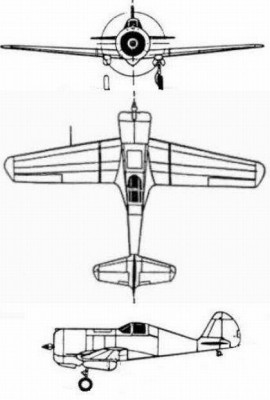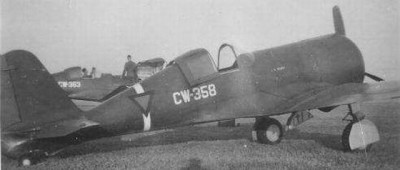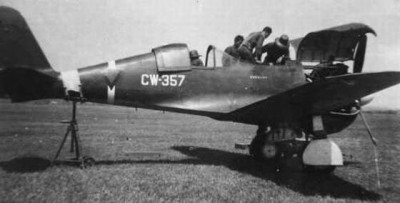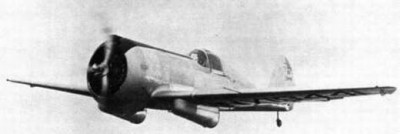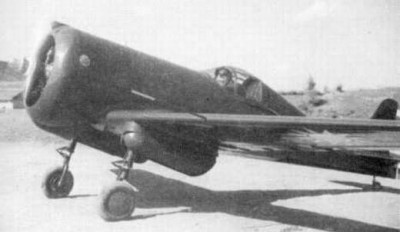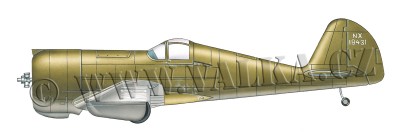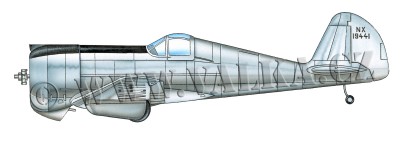| Název: Name: | Curtiss-Wright CW-21B Demon | Curtiss-Wright CW-21B Demon |
| Originální název: Original Name: | Curtiss-Wright CW-21B Demon | |
| Kategorie: Category: | stíhací letoun | fighter aeroplane |
| Výrobce: Producer: | DD.MM.1938-DD.MM.1941 Curtiss-Wright Corp., St. Louis, Missouri | |
| Období výroby: Production Period: | DD.MM.1938-DD.MM.1941 | |
| Vyrobeno kusů: Number of Produced: | 4 CW-21 24 CW-21B | |
| První vzlet: Maiden Flight: | 22.09.1938 | |
| Osádka: Crew: | 1 | |
| Základní charakteristika: Basic Characteristics: | ||
| Vzlet a přistání: Take-off and Landing: | CTOL - konvenční vzlet a přistání | CTOL - conventional take-off and landing |
| Uspořádání křídla: Arrangement of Wing: | jednoplošník | monoplane |
| Uspořádání letounu: Aircraft Concept: | klasické | conventional |
| Podvozek: Undercarriage: | zatahovací | retractable |
| Přistávací zařízení: Landing Gear: | kola | wheels |
| Technické údaje: Technical Data: | ||
| Hmotnost prázdného letounu: Empty Weight: | 1534 kg | 3382 lb |
| Vzletová hmotnost: Take-off Weight: | 2041 kg | 4500 lb |
| Maximální vzletová hmotnost: Maximum Take-off Weight: | ? kg | ? lb |
| Rozpětí: Wingspan: | 10.67 m | 35ft |
| Délka: Length: | 8.29 m | 27ft 2,5in |
| Výška: Height: | 2.49 m | 8ft 2in |
| Plocha křídla: Wing Area: | 16.19 m2 | 174,3 ft2 |
| Plošné zatížení: Wing Loading: | ? kg/m2 | ? lb/ft2 |
| Pohon: Propulsion: | ||
| Kategorie: Category: | pístový | piston |
| Počet motorů: Number of Engines: | 1 | |
| Typ: Type: | Wright R-1820-G5 o výkonu 634 kW třílistá stavitelná vrtule Hamilton-Standard | Wright R-1820-G5, power 850 hp three-blade variable-pitch propeller Hamilton Standard |
| Objem palivových nádrží: Fuel Tank Capacity: | 378 l | 100 US gal |
| Výkony: Performance: | ||
| Maximální rychlost: Maximum Speed: | 505.3 km/h v 3719 m | 314 mph in 12200 ft |
| Cestovní rychlost: Cruise Speed: | 453.8 km/h v ? m | 282 mph in ? ft |
| Rychlost stoupání: Climb Rate: | ? m/s | ? ft/min |
| Čas výstupu na výšku: Time to Climb to: | 4 min do 4000 m | 4 min to 13123 ft |
| Operační dostup: Service Ceiling: | 10455 m | 34300 ft |
| Dolet: Range: | 1013.9 km | 630 mi |
| Maximální dolet: Maximum Range: | ? km | ? mi |
| Výzbroj: Armament: | 2x pevný kulomet Browning ráže 12,7 mm nad motorem s 200 náboji na hlaveň 2x pevný kulomet Browning ráže 7,62 mm nad motorem se 480 náboji na hlaveň | 2x .30 Browning machine gun, 200 rpg 2x .50 Browning machine gun, 480 rpg |
| Uživatelské státy: User States: | | |
| Poznámka: Note: | - | - |
| Zdroje: Sources: | Bowers, P. M. Curtiss Aircraft 1907-1947, Putnam Aeronautical Books, London 1979. ISBN 0-370-10029-8. http://www.aerofiles.com/_curthyphen.html | |
Curtiss-Wright CW-21 Demon
One of the few types of modern aircraft that could withstand the Netherlands against the Japanese attack on their colonies in Southeast Asia (February 3, 1942) was 17 CW-21B Demon aircraft from the base in Perak. The Japanese pilots quickly and severely devastated these aircraft, it must be said that it was mainly due to the large number of numbers, as early as February 10, 1942, the Dutch had only six slightly damaged aircraft, which they withdrew to supplement the just delivered Hurricany Mk.II. March 8, 1942 The Dutch East Indies capitulated and the Japanese acquired the only aircraft that remained in airworthy condition.
One of the causes of this catastrophe was the failure to equip the aircraft with any passive defense. However, armored protection of the cockpit or engine was not considered at all, nor was self-locking fuel tanks, because this light fighter was planned exclusively for export to countries that needed to modernize their air force and had a limited budget for this modernization. Light fighters were created in the 1930s, mainly in France.
Curtiss-Wright Factory in St. Louis designed and built the aircraft, which had its foundations in a light attack aircraft CW-19R, the modification concerned the cabin, which was a single-seat for fighter purposes, was installed more powerful engine Wright R-1820-G5 Cyclone with an output of 1,000 horsepower. This engine was supercharged by a mechanical two-speed compressor, the engine power was transmitted using a three-bladed adjustable propeller Hamilton-Standard. The armament was relatively good for its time - two synchronized machine guns under the hood, one had a caliber of 7.62 mm and the other 12.7 mm. Increased performance was also achieved thanks to the retractable chassis. The design of the landing gear for the CW-21 aircraft underwent its development, in the first versions, the landing gear was pulled backwards into large protrusions at the bottom of the wings. In the later version of the CW-21B, the retraction system was improved and the removal of large bumps in the chassis brought an increase in speed from 488 km/h to 505 km/h.
The first prototype took off on September 22, 1938, the new aircraft from the very beginning of the tests climbed perfectly, this was achieved by the light weight of the aircraft and the engine, which thanks to a two-speed compressor delivered sufficient power in a decent altitude range.
Apart from the Netherlands, China took several machines earlier, originally it was supposed to be a fairly large order for thirty CW-21s, most of these aircraft were to be assembled at the CAMCO factory, the factory was damaged by a Japanese air raid. Several aircraft were sent to China in the already assembled form, three of these aircraft briefly operated in the unit A.V.G. The commander of the "flying tigers", Colonel Claire Chennault, counted on these aircraft to fight with high-flying Japanese reconnaissance aircraft. The great climb of "Interceptors" (this was the official name CW-21) was to be applied here. In the absence of any passive defense, these machines were not to operate against fighters or bombers. However, the aircraft were destroyed before they moved to the battlefield.
Now, we come to the part where we talk about the middle ground. The Curtiss-Wright factory demonstrated the CW-21 in Java in mid-1939, and finally American sales representatives managed to place an order for a total of 116 fighters, of which 24 were CW-21B.
The CW-21B version brought several major changes, it was the aforementioned chassis, which was newly retracted towards the fuselage, another change was double the armament and improved aerodynamics (retractable spur wheel and propeller cone). The Dutch version weighed 113 kg more, but mainly thanks to the new chassis, the maximum speed rose to 502 km/h. The Dutch allegedly valued their "Interceptors" more than Curtiss H-75A-7 or Brewster B-339 Buffalo.
Sources used:
William Green, War Planes of the Second World War, Volume Four: Fighters, London, MacDonald 7 Co. (Publishers) Ltd., 1969, ISBN 0-356-01448-7.
http://en.wikipedia.org/wiki/Curtiss-Wright_CW-21
http://www.airwar.ru/enc/fww2/cw21.html
http://www.warbirdforum.com/cw21.htm
www.greendyk.nl
author's archive
This post has not been translated to English yet. Please use the TRANSLATE button above to see machine translation of this post.
| Period | - |
| Producer | - |
| Type | - |
| Camouflage | - |
| Country | - |
| Pilot | - |
| Production No. | - |
| Serial No. / Evidence No. | - |
| Tactical Marking / Imatriculation | - |
| Name | - |
| Unit | - |
| Base | - |
| Date (DD.MM.RRRR) | - |
| Author | - |
| Print size / 300 DPI | - |
| Published with authors permit | - |
| Author Website | - |
This post has not been translated to English yet. Please use the TRANSLATE button above to see machine translation of this post.
| Period | - |
| Producer | - |
| Type | - |
| Camouflage | - |
| Country | - |
| Pilot | - |
| Production No. | - |
| Serial No. / Evidence No. | - |
| Tactical Marking / Imatriculation | - |
| Name | - |
| Unit | - |
| Base | - |
| Date (DD.MM.RRRR) | - |
| Author | - |
| Print size / 300 DPI | - |
| Published with authors permit | - |
| Author Website | - |
| Period | - |
| Producer | - |
| Type | - |
| Camouflage | - |
| Country | - |
| Pilot | - |
| Production No. | - |
| Serial No. / Evidence No. | - |
| Tactical Marking / Imatriculation | - |
| Name | - |
| Unit | - |
| Base | - |
| Date (DD.MM.RRRR) | - |
| Author | - |
| Print size / 300 DPI | - |
| Published with authors permit | - |
| Author Website | - |
| Period | - |
| Producer | - |
| Type | - |
| Camouflage | - |
| Country | - |
| Pilot | - |
| Production No. | - |
| Serial No. / Evidence No. | - |
| Tactical Marking / Imatriculation | - |
| Name | - |
| Unit | - |
| Base | - |
| Date (DD.MM.RRRR) | - |
| Author | - |
| Print size / 300 DPI | - |
| Published with authors permit | - |
| Author Website | - |
| Period | - |
| Producer | - |
| Type | - |
| Camouflage | - |
| Country | - |
| Pilot | - |
| Production No. | - |
| Serial No. / Evidence No. | - |
| Tactical Marking / Imatriculation | - |
| Name | - |
| Unit | - |
| Base | - |
| Date (DD.MM.RRRR) | - |
| Author | - |
| Print size / 300 DPI | - |
| Published with authors permit | - |
| Author Website | - |
This post has not been translated to English yet. Please use the TRANSLATE button above to see machine translation of this post.
| Period | Chino-japanese war [1931-1945] |
| Producer | Curtiss |
| Type | Curtiss-Wright CW-21 Demon |
| Camouflage | Prototypová |
 Olivově zelená / Olive Green Olivově zelená / Olive Green Šedá světlá / Light Grey Šedá světlá / Light Grey |
|
| Country |  |
| Pilot | - |
| Production No. | 21-1 |
| Serial No. / Evidence No. | - |
| Tactical Marking / Imatriculation | NX 19431 |
| Name | - |
| Unit | - |
| Base | - |
| Date (DD.MM.RRRR) | DD.09.1938 |
| Author | Zbyněk Válka |
| Print size / 300 DPI | A4 |
| Published with authors permit | Published with authors permit |
| Author Website | - |
První prototyp CW-21 výrobního čísla c/n 21-1 byl zalétán pilotem Nedem Warrenem 22. září 1938. Stroj byl opatřen civilní registrací NX 19431 na směrovém kormidle, levé spodní a pravé horní ploše křídla. V únoru 1939 jej v Číně předváděl v simulovaných soubojích tovární pilot Robert Fausel. Letoun tehdy dostal čínské výsostné znaky, ačkoliv byl stále majetkem firmy Curtiss-Wright. Během japonského útoku na Čínu v březnu 1939 se Fausel v kokpitu tohoto stroje přidal k obráncům a 2. 4. 1939 poškodil a přinutil k přistání japonský Fiat BR.20. Čínská vláda později letoun odkoupila, avšak patrně již v červnu 1939 byl ztracen při havárii.
Published with authors permit
This post has not been translated to English yet. Please use the TRANSLATE button above to see machine translation of this post.
| Period | Chino-japanese war [1931-1945] |
| Producer | Curtiss |
| Type | Curtiss-Wright CW-21 Demon |
| Camouflage | Civilní |
 Kov, stříbrná / Metalic, silver Kov, stříbrná / Metalic, silver Černá / Black Černá / Black |
|
| Country |  |
| Pilot | - |
| Production No. | 21-2 |
| Serial No. / Evidence No. | - |
| Tactical Marking / Imatriculation | NX 19441 |
| Name | - |
| Unit | - |
| Base | - |
| Date (DD.MM.RRRR) | 20.03.1940 |
| Author | Zbyněk Válka |
| Print size / 300 DPI | A4 |
| Published with authors permit | Published with authors permit |
| Author Website | - |
První ze tří sériových CW-21 (c/n 21-2) vyrobených pro čínského zákazníka. Stroj byl zalétán pilotem W. Wellsem v St. Louis 20. 3. 1940. Letouny měly na základě čínských požadavků zesílenou výzbroj (2 x 12,7mm kulomet a 2 x 7,62mm kulomet). V USA ovšem stroj létal jako civilní, tj. bez výzbroje a s registrací NX 19441). Všechny tři letouny byly dodány do Číny během roku 1940. Na jaře 1941 byly začleněny do American Volunteers Group "Flying Tigers". Všechny tři stroje byly ztraceny 23. 12. 1941, když do nich pozemní personál na barmském letišti Lashio natankoval špatné PHM a všechny po startu kvůli potížím s motory havarovaly, jeden pilot zahynul. Letoun Létal celý v barvě kovu, až na černý pás proti oslnění před kabinou. Černá registrace na směrovce, levé spodní a pravé horní ploše křídla.
Published with authors permit
This post has not been translated to English yet. Please use the TRANSLATE button above to see machine translation of this post.
| Period | - |
| Producer | Curtiss |
| Type | Curtiss-Wright CW-21 Demon |
| Camouflage | Standardní vojenská |
 Zelená tmavá / Dark Green Zelená tmavá / Dark Green Hnědá / Brown Hnědá / Brown Šedá světlá / Light Grey Šedá světlá / Light Grey |
|
| Country |  |
| Pilot | - |
| Production No. | 2852 |
| Serial No. / Evidence No. | C-383 |
| Tactical Marking / Imatriculation | - |
| Name | - |
| Unit | - |
| Base | - |
| Date (DD.MM.RRRR) | DD.09.1940 |
| Author | Zbyněk Válka |
| Print size / 300 DPI | A4 |
| Published with authors permit | Published with authors permit |
| Author Website | - |
První sériový CW-21B, určený pro vojenské letectvo Nizozemské východní Indie, byl v St. Louis zalétán v polovině září 1940. Již v USA dostal nizozemskou kamufláž, avšak bez výsostného označení, a také registraci C-338, která však nekorespondovala s nizozemským systémem označování. Po odeslání do Nizozemské východní Indie (zima 1940/41) obdržel nizozemské výsostné znaky a standardní označení CW-343m.
Published with authors permit
Join us
We believe that there are people with different interests and experiences who could contribute their knowledge and ideas. If you love military history and have experience in historical research, writing articles, editing text, moderating, creating images, graphics or videos, or simply have a desire to contribute to our unique system, you can join us and help us create content that will be interesting and beneficial to other readers.
Find out more